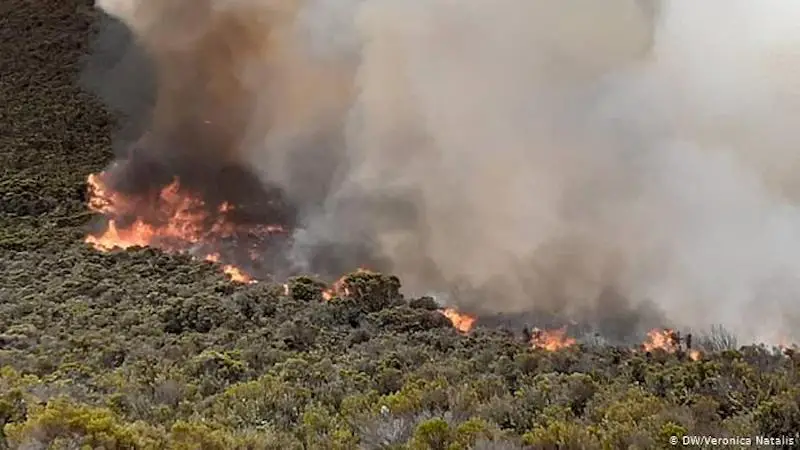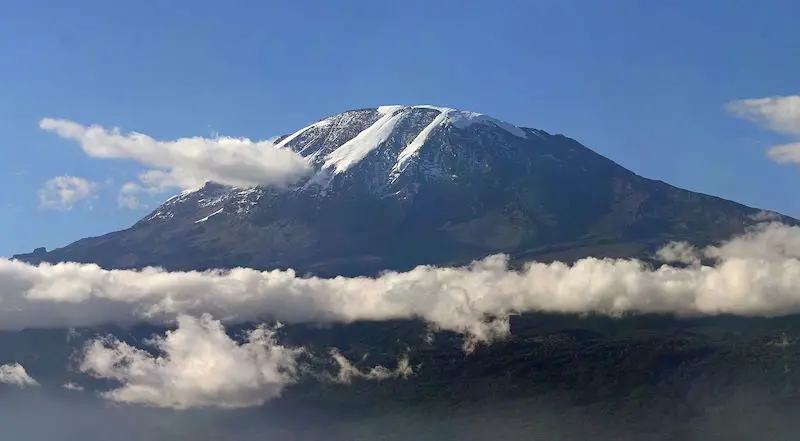For decades trekking to the lofty summit of Mt. Kilimanjaro has been one of the top bucket-list items for any serious adventure traveler. As Africa’s highest peak—and the tallest free-standing mountain in the world—it routinely draws thousands of visitors each year.
Even in 2020, amidst a global pandemic, it has remained open to visitors, with small teams of climbers socially distancing their way to the top. In recent years the impact of climate change on the mountain has become increasingly evident.
The once-famous snows of Kilimanjaro have been melting at an alarming rate, and the glacier that lined its volcanic crater has shrunken to just a shadow of its former self. In fact, climatologists now say that the glacier will likely be completely gone by 2033, limiting the amount of freshwater available to the local Tanzanians living long Kili’s base.
Recently however, a new threat has emerged to the health of the mountain. One that has the potential to do more immediate damage and have a lasting impact on the local ecosystem. As wildfires on Kilimanjaro now show that the iconic peak is under siege on multiple fronts, with warming temperatures and drying conditions creating new challenges.

Wildfires on Kilimanjaro
A few weeks back, in mid-October, a massive wildfire broke out along Kilimanjaro’s flanks. It is believed that the fire was started by porters who were cooking a meal for their guests at the Whona Camp.
Sparks from a cooking fire may have landed in the nearby grass, igniting a blaze that burned for several days and required more than 500 volunteer firefighters to extinguish. Because it is currently the dry season in Tanzania, it didn’t take long for the fire to spread, scorching a large section of the mountain.
Because the fire ignited at about 8850 feet (2697 m) —and spread to as high as 12,100 (3688 m)— it wasn’t easy to contain. Just getting the necessary resources onto the mountain was a challenge, and rangers at Kilimanjaro National Park didn’t have immediate access to a helicopter to help combat the blaze. As a result, the wildfire burned more than 36.7 square miles (95 sq. km), destroying wildlife and vegetation in the process.
It took firefighters five days to get the wildfire under control. During that time, it managed to destroy more than a dozen houses, several campsite facilities, and a few solar panels.
Thankfully no one was seriously injured in the blaze and visitors to the mountain saw only minor disruptions. The small number of trekking teams currently on Kilimanjaro made it easier to keep track of where climbers were during the worst of the conditions.
More Fires Expected in the Future
While wildfires on Kilimanjaro aren’t unheard of, they don’t occur all that often either. The one that occurred a few weeks back is now considered the largest ever to take place on Africa’s tallest peak, although it may not hold that distinction for long.
Park rangers and locals living in the mountain’s shadow have indicated that the shrinking glaciers and warming conditions have made the dry season even more dangerous than it was in the past.
As a result, officials say they expect these types of fires to become more common—and grow in intensity—in the future. Because of this, they are working to become better prepared to handle them.
Part of that preparation includes training the volunteer firefighters to be more effective at their job. It also means investing in better equipment, including purchasing a helicopter specifically designated for the national park.
That should help when it comes to scouting for fires and delivering supplies and personnel to the mountain in a more expedient manner. Had a helicopter been available this time out, the blaze may have been contained much more quickly.
One thing that park officials can’t control is the shifting climate conditions on Kili, however. As the rainy season gets shorter and the dry season grows longer and drier, the chances of more fires become a distinct possibility.
This is especially true when more people are on the mountain, as they’re traditionally are at this time of the year. COVID-19 has kept most trekkers at home, but in the future, there will likely be more cook fires for preparing meals, increasing the chance of a spark igniting the surrounding landscape.
Climate Change is Accelerating
Climatologists have been warning us for years that Kilimanjaro was under threat, and the changes to the mountain are now undeniable. But at this point, it seems that the impact of climate change is starting to accelerate, with the glaciers on the summit losing significant mass in just the past decade alone.
The loss of that ice has had a cascading effect on the surrounding ecosystem, causing streams and rivers to dry up and forcing farmers to live at the base of the mountain to find alternate water sources. Naturally, this has led to drier conditions, which directly feeds the potential for more wildfires.
Just how much have Kili’s glaciers shrunken in recent years? According to scientists, when the mountain was first climbed back in 1889, the ice sheets once covered approximately 4.75 sq. miles (12.3 sq. km).
By 2003, their size had been reduced to just .96 sq miles (2.5 sq. km). Today, they are just a fraction of even that number, with annual snowfall—which typically feeds the glacier—dropping off dramatically too.
We’ve known for years that Kilimanjaro was at the epicenter of climate change, serving as a “canary in the coal mine,” if you will. But the dramatic shift in the size of the glaciers in recent years, along with the growing threat of increased forest fires, has further hammered this point home.
This mountain will look like in another 10-15 years remains to be seen. The impact of its changing environments and ecosystems is likely to have long-lasting effects on the people who have relied on it for water and a livelihood.
Make no mistake; Kilimanjaro isn’t the only place where climate change has a major impact. Right now, however, it just happens to be one of the starkest examples of what we can expect in the decades to come.
- Gear Review: The Xero Scrambler Mid is an Ultralight Hiking Shoe for Spring - March 1, 2023
- Gear Review: Yeti Roadie 48 Wheeled Cooler - August 18, 2022
- Kristin Harila Continues Pursuit of 8000-Meter Speed Record - August 16, 2022

Good piece Kraig. When I climbed in 2011, climatologist predicted all the glaciers would be gone by 2020, and here we are with them sill there, albeit smaller. There have been some aggressive and impressive efforts to slow the local impact of global climate change by planting 100,000’s trees in the volcano’s ecosystem. You can read more at http://www.trees4kili.org/the-science.html
The difference in the glaciers from my first visit in 2007 and my second in 2015 was noticeable. Yes, they’re still there, but in dramatic decline. There is a good chance they’ll be gone in our lifetime. Kili and Tanzania are some of my favorite places, so I worry for their future, but glad there are efforts being made to save them.
Great article Kraig! It seems with the media’s focus on Covid-19 and the US election, the fires on Kilimanjaro just a few weeks ago went barely unnoticed. Like you I think fires on Kili are unfortunately going to become more frequent due to hotter and drier Summers and increased tourist activity on the mountain. Sadly, the Tanzanian government is woefully unprepared for major fires like the one they just experience. If it were not for the 500+ volunteers (mainly porters and guides) who helped put out the flames in the most recent blaze, I think things would have been much worse. As for the impact of climate change on Kili’s glaciers, I noticed a significant change from my visit in 2013 to my more recent visit in 2019. I think it is inevitable that they will sadly be gone within our lifetime. Keep up the great reporting!